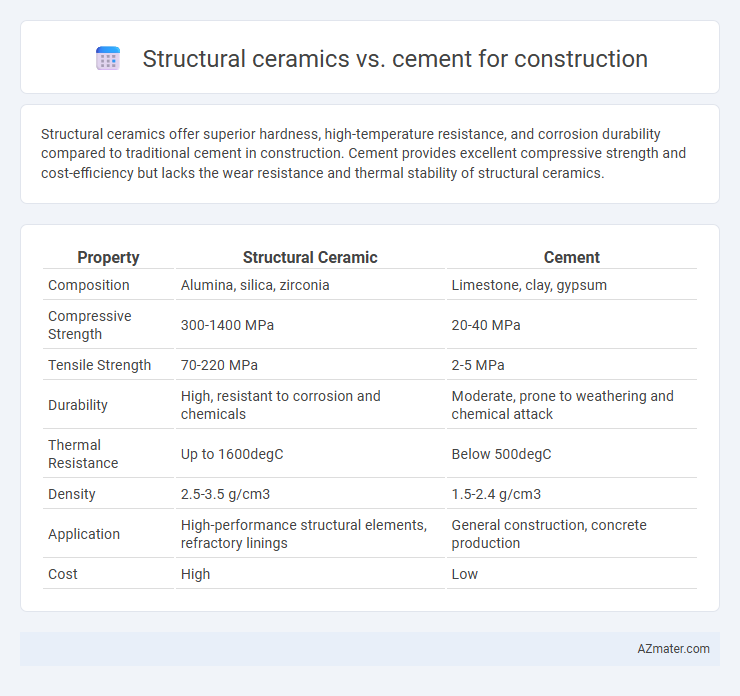Structural ceramics offer superior hardness, high-temperature resistance, and corrosion durability compared to traditional cement in construction. Cement provides excellent compressive strength and cost-efficiency but lacks the wear resistance and thermal stability of structural ceramics.
Table of Comparison
| Property | Structural Ceramic | Cement |
|---|---|---|
| Composition | Alumina, silica, zirconia | Limestone, clay, gypsum |
| Compressive Strength | 300-1400 MPa | 20-40 MPa |
| Tensile Strength | 70-220 MPa | 2-5 MPa |
| Durability | High, resistant to corrosion and chemicals | Moderate, prone to weathering and chemical attack |
| Thermal Resistance | Up to 1600degC | Below 500degC |
| Density | 2.5-3.5 g/cm3 | 1.5-2.4 g/cm3 |
| Application | High-performance structural elements, refractory linings | General construction, concrete production |
| Cost | High | Low |
Introduction to Structural Ceramics and Cement
Structural ceramics exhibit exceptional hardness, high compressive strength, and thermal stability, making them ideal for applications requiring durability and resistance to wear in construction. Cement, a primary binder in concrete, provides versatility, strong adhesion, and ease of use, enabling it to form complex shapes and structures when mixed with aggregates. Both materials play crucial roles in modern construction, with ceramics offering superior performance in specialized environments and cement serving as the foundational component for widespread building projects.
Composition and Material Properties
Structural ceramics are composed of inorganic, non-metallic materials such as alumina, silicon carbide, and zirconia, characterized by high hardness, heat resistance, and excellent compressive strength. Cement primarily consists of calcium silicates, aluminates, and ferrites, offering strong adhesive properties and good tensile strength after hydration and curing. Compared to cement, structural ceramics exhibit superior wear resistance and thermal stability but are more brittle, influencing their application in construction where durability under stress and temperature variations is critical.
Mechanical Strength Comparison
Structural ceramics exhibit superior mechanical strength compared to cement, with higher compressive and tensile strengths reaching up to 1,000 MPa and 200 MPa respectively, whereas cement typically provides compressive strength around 20-50 MPa and limited tensile capacity. The intrinsic microstructure of ceramics, characterized by strong ionic and covalent bonds, allows for enhanced hardness and wear resistance, making them suitable for high-stress applications. Cement's mechanical properties depend heavily on curing time and environmental conditions, resulting in more variability and generally lower strength performance than structural ceramics in demanding engineering contexts.
Durability and Longevity
Structural ceramics exhibit superior durability and longevity compared to cement due to their inherent resistance to corrosion, chemical attack, and extreme temperatures. Cement, while versatile and widely used, is prone to cracking, weathering, and degradation over time, especially under harsh environmental conditions. The enhanced thermal stability and mechanical strength of structural ceramics make them ideal for long-term construction applications requiring minimal maintenance.
Thermal Insulation Capabilities
Structural ceramics exhibit superior thermal insulation capabilities compared to cement, owing to their low thermal conductivity and high resistance to heat transfer. These ceramics maintain structural integrity under extreme temperature conditions, making them ideal for applications requiring thermal protection and energy efficiency. Cement, while effective for general construction, typically has higher thermal conductivity, resulting in less efficient insulation properties.
Resistance to Chemical and Environmental Factors
Structural ceramics exhibit exceptional resistance to chemical corrosion and environmental degradation due to their dense, stable crystal lattice and inert chemical composition, making them ideal for harsh conditions involving acids, alkalis, and high temperatures. Cement, though widely used in construction, is more susceptible to chemical attack from sulfates, chlorides, and carbonation, which can lead to weakening and deterioration over time, especially in aggressive environments. The superior chemical and environmental resistance of structural ceramics ensures longer durability and reduced maintenance in applications exposed to extreme or corrosive conditions.
Sustainability and Environmental Impact
Structural ceramics offer superior durability and thermal resistance compared to cement, significantly reducing maintenance and energy consumption over a building's lifecycle. Cement production is responsible for approximately 8% of global CO2 emissions, whereas structural ceramics involve lower embodied carbon due to less energy-intensive manufacturing processes. Utilizing structural ceramics in construction enhances sustainability by minimizing raw material extraction and promoting longer-lasting, recyclable building components.
Cost Analysis and Economic Considerations
Structural ceramics offer superior durability and resistance to environmental degradation compared to traditional cement, often resulting in lower long-term maintenance costs despite higher initial investment. Cement remains more cost-effective upfront due to its widespread availability and established production processes, making it a preferred choice for large-scale, budget-sensitive projects. Economic considerations must balance the higher initial cost of ceramics against potential savings from extended lifespan and reduced repair expenses in critical or high-performance construction applications.
Applications in Modern Construction
Structural ceramics offer high wear resistance, thermal stability, and excellent compressive strength, making them ideal for specialized applications like heat-resistant tiles, cutting tools, and advanced cladding systems in modern construction. Cement remains the cornerstone material in structural frameworks, used extensively in concrete production for foundations, beams, and columns due to its cost-effectiveness and versatility. The integration of ceramic composites with cementitious materials is emerging, enhancing durability and sustainability in innovative building designs.
Future Trends and Innovations
Structural ceramics in construction offer superior durability, resistance to high temperatures, and chemical stability compared to cement-based materials, driving innovation in sustainable building solutions. Emerging trends include the development of nanostructured ceramic composites that enhance mechanical strength and reduce environmental impact by lowering carbon emissions associated with traditional cement production. Advances in additive manufacturing and 3D printing techniques enable the fabrication of complex ceramic components, expanding their applications in resilient infrastructure and smart building technologies.

Infographic: Structural ceramic vs Cement for Construction
 azmater.com
azmater.com